Sam Gilliam, D.C. Artist of Worldwide Acclaim
By • June 30, 2022 One Comment 2178
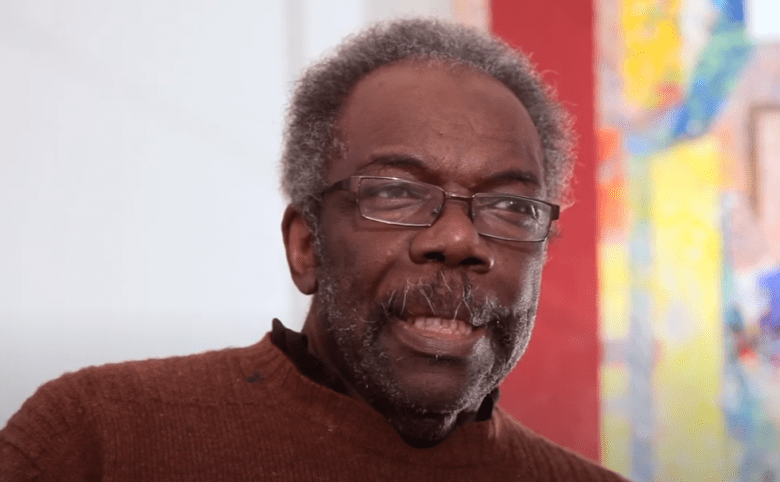
Sam Gilliam, among the most important artists ever to commit to living and working in the nation’s capital — which he did for 60 years — died of kidney failure at his Washington, D.C., home on June 25. He was 88.
The last living representative of the Washington Color School movement that put the District of Columbia on the contemporary art map in the 1950s and 1960s, Gilliam achieved worldwide acclaim as an independent and, into his 80s, undiminished creative force.
Gilliam was also beloved in the District for decades of inspiring and mentoring young people, beginning with five years of teaching at McKinley Technical High School and participation in the workshops that preceded the launch of Duke Ellington School of the Arts.
Born on Nov. 30, 1933, in Tupelo, Mississippi, he was the second-youngest of eight children in a family that later moved to Louisville, Kentucky. His seamstress mother encouraged his early fascination with drawing; horses were a favorite subject. Reports vary as to his father’s occupation — farmer (New York Times)? railroad worker (Artnews and NPR)? truck driver (Guardian)? carpenter (Washington Post)? — but he likely inherited a certain manual aptitude from Sam Sr.
Gilliam reached adulthood during the early years of integration. After attending Louisville’s segregated Central High School, he became a member of the second admitted class of Black undergraduates at the University of Louisville, graduating in 1955. Before returning to get a Master of Fine Arts degree, he spent two years stationed in Japan as a U.S. Army clerk. In 1962, just married to Dorothy Butler, The Washington Post’s first Black female reporter, he settled in D.C.
Sam and Dorothy Butler Gilliam were divorced in the 1980s. In 2018, he married his longtime partner Annie Gawlak, director of the former G Fine Art at 1515 14th St. NW, who survives him, as do three daughters from his first marriage.
Referencing jazz in connection with Black visual art has become a cliché. In the case of Gilliam, who in his teens and twenties experienced the music’s transition from bebop to free jazz, the parallel is key to his artistic path. He was just seven years younger than Miles Davis and John Coltrane and three years younger than Ornette Coleman.
Coltrane was a particular influence. Interviewed in 1984 for the Archives of American Art by Kenneth Young, his University of Louisville classmate (and the Smithsonian’s first Black exhibition designer), Gilliam said: “We used to talk about Coltrane — that Coltrane worked at the whole sheet, he didn’t bother to stop at bars and notes and clefs and various things, he just played the whole sheet at once.”
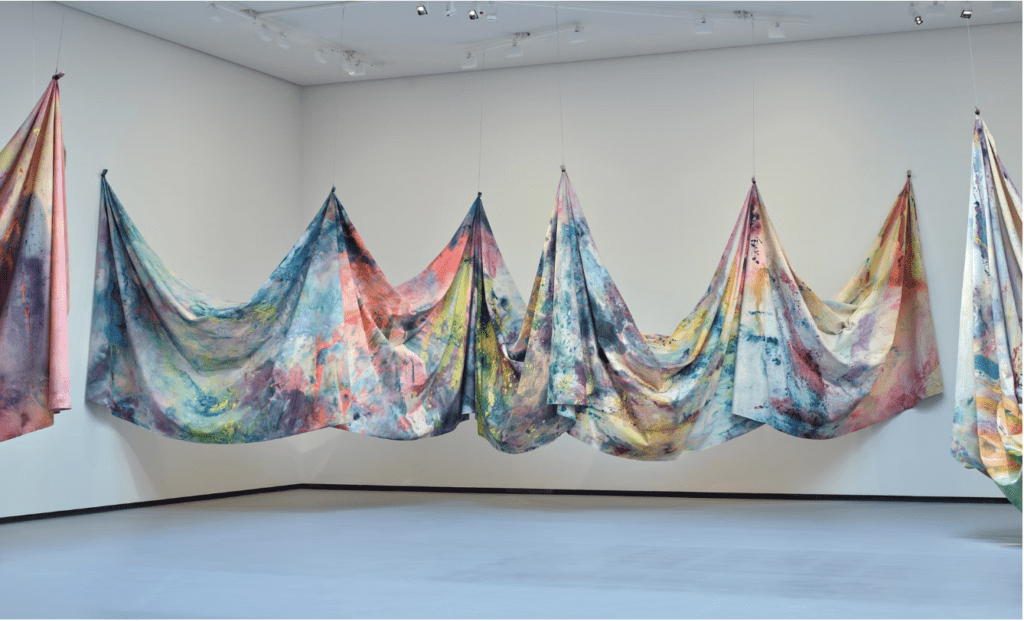
© Sam Gilliam / ADAGP, Paris 2022. Photo © Fondation Louis Vuitton / Marc Domage.
Playing the whole sheet at once — staining, marking up and layering paint on large sections of unframed canvas that he folded, then draped — was what made Gilliam famous. These breathtaking “drape” paintings, semi-improvised color abstractions, perform on the tightrope between painting and sculpture, interacting with the spaces they occupy and taking a different form with each installation.
“Baroque Cascade,” 75 feet long undraped, was a sensation at the 1972 Venice Biennale, where Gilliam was the first Black artist to represent the U.S. The group show — also featuring, among others, Diane Arbus and Richard Estes — was curated by Walter Hopps in his last year as director of the Corcoran Gallery of Art.
Having begun to make frameless works in the 1960s — inspired by the mostly older Color School painters connected with the Washington Gallery of Modern Art, a cultural landmark of 1960s Dupont Circle — Gilliam explored this signature genre throughout his long career. Supported by sawhorses, attached to walls like oversized bunting, cascading from ceilings, examples are now found in many museums and public spaces. Invited back to Venice 45 years later, Gilliam created a draped piece, “Yves Klein Blue,” that brightened the entrance to the 2017 Biennale.
On that occasion, Gilliam spoke to Artforum about the first outdoor installation, by hook-and-ladder truck, of a draped work, “Seahorses,” in 1975. Three huge canvas loops, dominated by reds, oranges and yellows, festooned a sheer stone sidewall of the Philadelphia Museum of Art. When a storm blew in, Gilliam recalled: “There was this really beautiful moment when the strong winds inhabited the piece — rays of light shot through the fabric, creating shadows in the folds.”
Over the decades, Gilliam experimented with several other styles, notably the collaging of pieces of painted canvas onto wooden forms with hard, beveled edges. The range of his work was first fully displayed in “Sam Gilliam: A Retrospective,” organized by the Corcoran’s then-curator of contemporary art, Jonathan Binstock. After its Corcoran run from October of 2005 to January of 2006, the show traveled to Louisville, Savannah and Houston.
The Corcoran, under Hopps, had given Gilliam prominent early exposure at a 1969 exhibition — the Beaux-Arts building’s skylights are ideal fixtures from which to dramatically hang his show-stopping canvases — but the Phillips Collection was the first D.C. museum to present a solo show, two years earlier.
New York recognition was infrequent and piecemeal: work by Gilliam and by sculptor Melvin Edwards was shown at the Studio Museum in Harlem in 1969; MoMA gave Gilliam a “Projects” exhibition in 1971; and he had a solo show at the Studio Museum in 1982. His first solo show at a Manhattan gallery (Mnuchin) did not come about until 2017.
Fortunately, his longevity enabled Gilliam to witness the current period of widespread recognition. In 2015, he received the Medal of Arts Lifetime Achievement Award from the U.S. State Department. An artistic centerpiece of the Reach complex that opened at the Kennedy Center in 2019 is a drape painting, “Carousel Light Depth.”
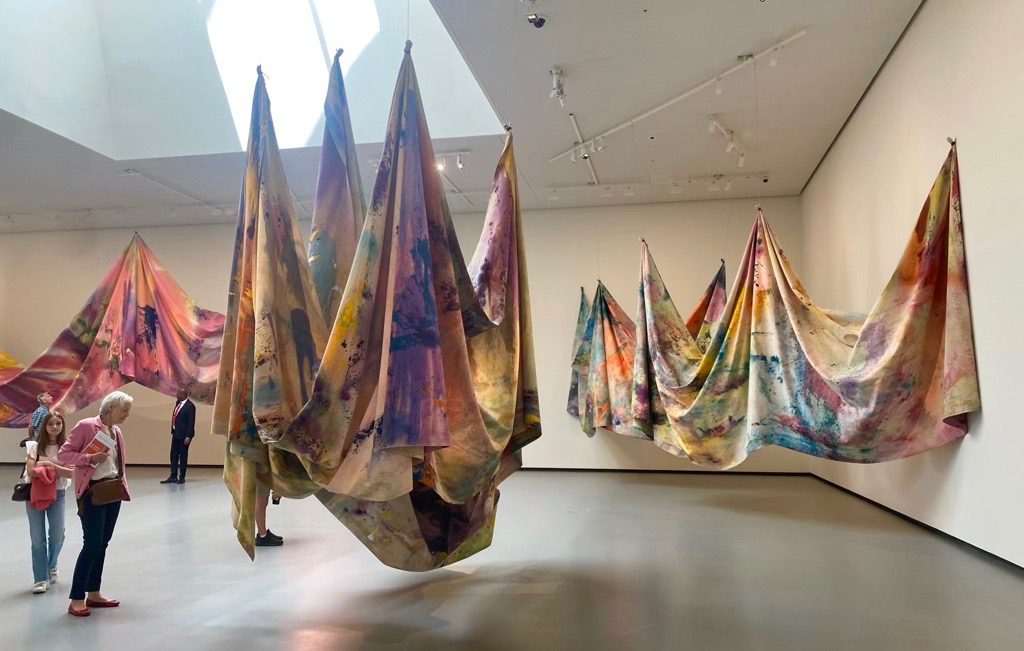
Sam Gilliam’s works are currently on display at Fondation Louis Vuitton in Paris. Photo by Sonya Bernhardt.
At the end of 2020, Gilliam’s inaugural exhibition at Pace Gallery, Gilliam’s first New York representative, showed a novel body of sculptural work: stained plywood and aluminum pyramids created after a Swiss sojourn to prepare for a 2018 Kunstmuseum Basel show. Pace founder Arne Glimcher, an admirer for many years, wrote of his visits to Gilliam’s studio: “It reminded me of visiting Rothko in my twenties.”
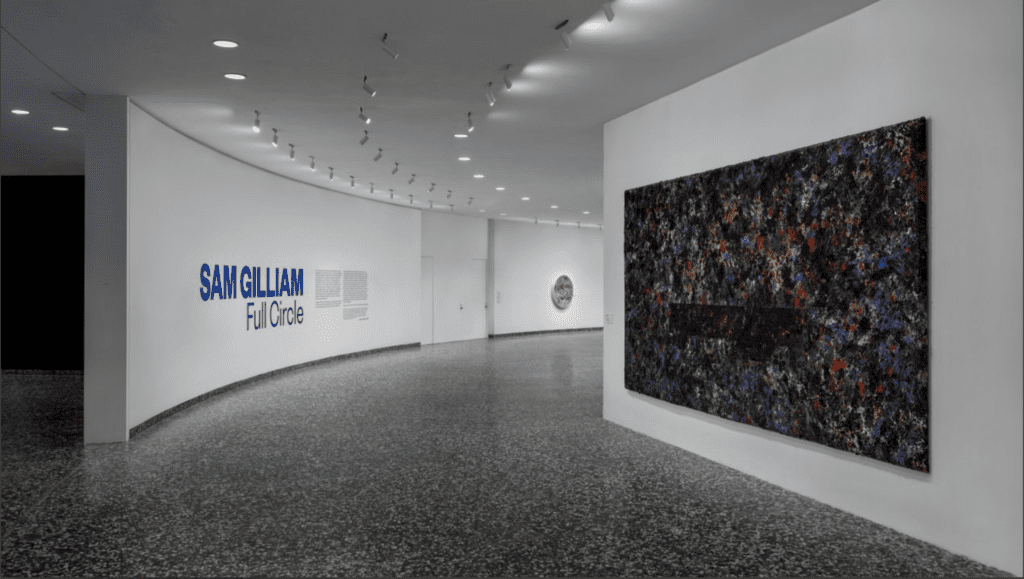
“Sam Gilliam: Full Circle” is on display at the Hirshhorn through Sept. 11.
The Hirshhorn Museum exhibition “Sam Gilliam: Full Circle,” which opened in May and runs through Sept. 11, was originally intended as a 2020 retrospective. Delayed by the pandemic, it instead showcases a recent series of round (“tondo”) paintings, along with “Rail,” a 1977 work in the Hirshhorn’s collection.
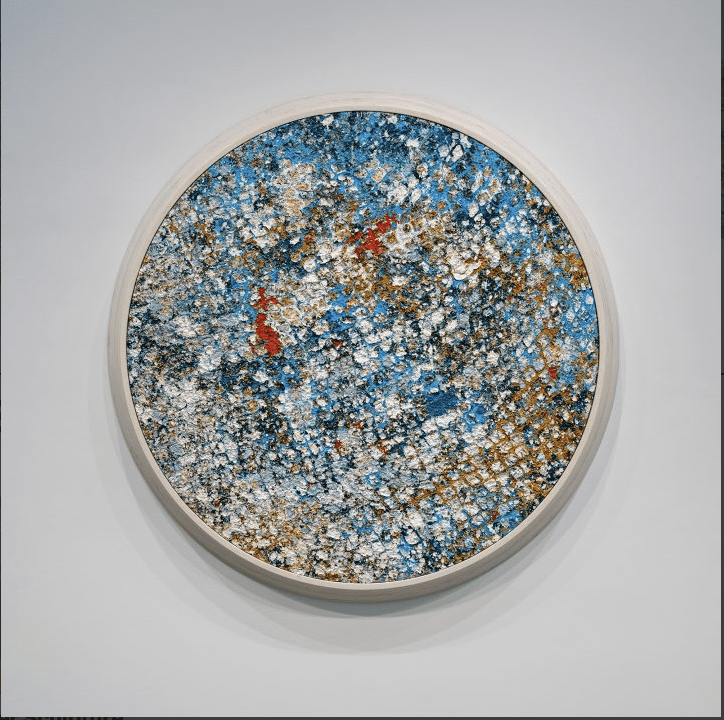
You Blue Moon, 2021. Acrylic and mixed media on panel in beveled frame. Courtesy Jeffrey Pechter. 2022. Photo by Ron Blunt. On display at the Hirshhorn through Sept. 11.
Appropriately for a great African American artist, who supported Black causes while developing a personal, universal aesthetic, a work by Gilliam was commissioned for permanent display at the Smithsonian’s National Museum of African American History and Culture. “Yet Do I Marvel” is a five-panel wall piece named for a 1925 poem by Countee Cullen. The poem’s concluding lines: “Yet do I marvel at this curious thing:/To make a poet black, and bid him sing!”


Nice article.